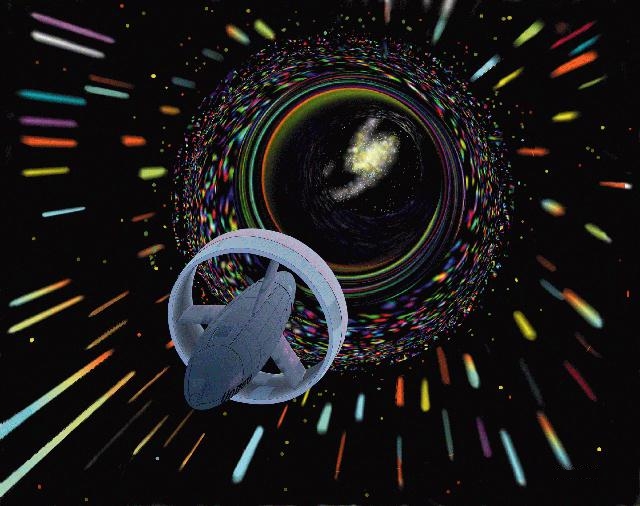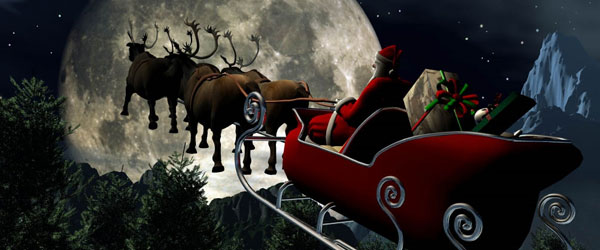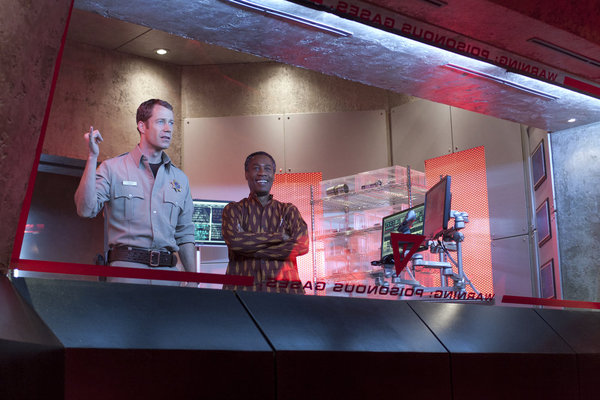Santa Part 3: Around The World

In Part 1, I laid out a massive challenge. That challenge is to explain how Santa Claus could exist in the real world. Setting out on this challenge involves a whole lot of speculation backed by actual, or at least theoretical, science. In Part 2, I managed to explain both the North Pole Village and the longevity that Santa Claus has. At least, it was done to some acceptable level. Now it’s time to look at how to get a sleigh and reindeer to defy the law of gravity, and fly around the world in defiance of the Theory of Relativity. After all, who needs Einstein when you have advanced elf technology?
So we’re going to have to look at two things. First is the challenge of getting the sleigh and reindeer off the ground and into flying mode. That won’t be an easy task without wings and a proper aerodynamics. Then we will talk about the ability to break the light barrier without cooking Santa and the deer. That should also be a bit of a chore. We’ve got a lot ahead of us, so let’s get cracking!

Getting High With The Fat Bearded Man
I’m not interested in getting into details about how to keep reindeer from pooping on innocent bystanders at great heights or anything like that. My focus here is solely on getting the big sled and eight large quadrupeds off the ground in sustained flight. We can start off by ruling out cannons and catapults. That is not sustained flight. Also, it’s not likely to be accurate over an intercontinental distance. In addition, it’s only a one-way trip. One roof landing and Saint Nick is left stranded, having to work out the details with the insurance companies.
That being said, and assuming there’s no pixie dust and happy thoughts involved, are there ways to get flight out of a sleigh and reindeer? Let’s look at some options.
1. Rockets
Seriously? Rockets??
Rockets or jet engines (either one) will only make for strong thrust. Without wings of sufficient size, all you get is a really fast sled and deer turned into messy ground venison. Sure, there could be downward-thrusting engines, but do you have any clue as to how much fuel it would take for Santa to do all of his rounds in this fashion? Tons. There’s no room on the sleigh for that kind of fuel.
And don’t tell me that it could be a small nuclear reactor. Nuclear-powered vehicles (like naval warships) don’t really run on nuclear power. They run on glorified steam engines. But instead of wood or coal to provide the heat, they rely on nuclear fission. Steam engines are out of the question. And no, it wouldn’t use the nuclear reaction itself as a means of propulsion. Do you realize the radiation risk in something like that?
The only way that I could believe the whole rocket theory is if it were a matter/antimatter reaction. Only then would there be sufficient thrust to sustain proper flight on a minimal amount of fuel. But that sucker would be extremely loud!
2. Flying Fickle Finger Of Force Field
[youtube=http://www.youtube.com/watch?v=SeB69CcLEI8]
Perhaps an ultrasonic force field might be in order. Researchers at the University of Dundee have invented a primitive form of the Doctor’s Sonic Screwdriver. Using ultrasonic sound waves, they were able to suspend and spin a rubber disk … which was submerged in water. Even though it required water to function, they have still proven the theory. Could a more advanced form of this kind of technology propel Santa’s private jet? Hard to say. But in some ways, it’s not unlike the rocket/jet idea. Though my thinking is that unless it’s directly pushing directly on the ground below, causing the sleigh to “walk”, then propelling the sleigh from on board the sleigh itself is not unlike grabbing your pant legs, pulling up, and seeing how long you can hold yourself up in the air. It doesn’t work.
3. Let’s Get Warped
The final option I’ll look at is a fun way to manipulate relativity. It’s called a warp drive. I’ve mentioned this technology in previous articles and is one of my personal favorite sci-fi technologies. Although utilized on Star Trek as far back as TOS, no workable theory existed until 1994. It was then that Mexican physicist Miguel Alcubierre figured out mathematically how to produce a warp field to travel faster than light. Using the quantum mechanical Casimir Effect, a “bubble” of negative energy is created around a football-shaped ship, using a suspended nacelle ring around the ship, that would shorten space between the vessel and its destination, thereby creating a shortcut between two points. Unfortunately, it would require a force equal to the weight of Jupiter to get it to achieve 10c (10 times the speed of light) as hoped.
Then just this year (2012), Dr. Harold “Sonny” White, a researcher at NASA, decided to throw different numbers at the equation just to see what would happen. He found a way to reduce the power requirement to an equivalent of the weight of a Ranger space probe! So far, the negative energy that has been produced in a lab is equivalent to the weight of a red blood cell. Oh, well. It’s a start.
But what about flight, not just propulsion? The warp bubble is an interesting phenomenon in which, while a ship would seem to be moving quickly relative to the universe, those inside the bubble would think the universe is moving quickly relative to the ship. Those in the bubble stand still while the rest of the universe moves. So if a civilization were advanced enough (like the elves), then they might be able to find a way to create a bubble that can move the sleigh independently from the world around it. No fairy dust, just science.

Ultra-Fast Delivery
Then there’s the issue of moving and making deliveries so fast without bursting into supernova-like flames. Santa would have to move so fast that every character in a Jimmie John’s radio commercial would stand in awe. He would also have to do it without succumbing to the effects of wind resistance. When orbital spacecraft reenter the atmosphere, they use the atmosphere itself to provide the brakes. But at orbital speeds (which is but a tiny fraction of the speed Santa needs to achieve), heat shielding is required. Otherwise the spacecraft is almost instantly destroyed. So how can the jolly fat man avoid such a horrendous fate?
1. Let’s Get Warped … Again
Since the warp drive was mentioned in the last section, it might be good to mention it again. Not only could the negative energy bubble allow the sleigh to fly, it could allow it to move faster than light! But at that speed, I’m not sure whether or not wind resistance would still be a problem. Logically, I would say no. When the bubble moves everything around the vessel I mean everything, including the atmosphere.
2. Time Warp
No, I’m not referring to jumping to the left and stepping to the right. What I mean by warping time is that, much like a warp drive can bend space, there could be a way to warp time as well. This would give Santa additional time to work. Right now, the known way to manipulate time is by … uh … manipulating gravity.
Okay, so this one was a stupid idea.
3. Santa Clone Is Coming To Town
When discussing Santa’s ability to age well, I mentioned the use of quantum entanglement as a means of producing a new Santa every year. But what if it was a whole bunch of Santas? Using this method, the elves could theoretically create more Santas than exist on the streets of NYC on Christmas Eve! Now that’s a lot of Santas! The more Santas there are, the less speed is required by each one to deliver all those lovely little presents all over the world.
So there you have it. Santa can fly and do so all up in Einstein’s face. But that’s not quite the end of it …
![]()




